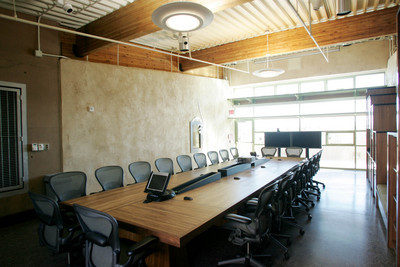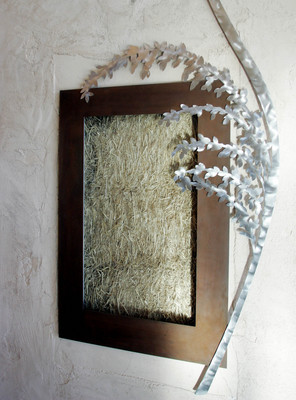Meetings go green
At roughly 50,000 square feet, the meeting space inside the Las Vegas Springs Preserve is small compared with the multimillion-square-foot convention centers near the Strip.
But the preserve's meeting areas are having a big impact on the convention industry, giving local companies pointers on how to hold ecoconscious meetings and drawing nationwide attention from exhibit businesses interested in capitalizing on the growing demand for green trade shows.
Since the preserve opened in June, the cultural attraction's corporate-function space has garnered coverage in magazines, including Successful Meetings. Special Events magazine in July put the preserve's meeting space on its "Green Giants" list of environmentally sensitive venues. The list also featured profiles on major centers in Toronto, San Francisco and Melbourne, Australia.
Thanks partly to all that attention, the group-sales team at the preserve "cannot keep up" with queries from companies looking to rent space, said Jesse Davis, a former spokesman for the preserve who now works full-time for the preserve's parent organization, the Las Vegas Valley Water District.
Among the businesses and nonprofits who have booked meeting space at the preserve are the Urban Land Institute, the National Association of Realtors, Sherwin-Williams, Wynn Resorts Ltd., Starbucks, the Andre Agassi Charitable Foundation, U.S. Bank, the Southern Nevada Home Builders Association and the YMCA.
The popularity of the preserve's meeting space shows the growing importance businesses place on corporate responsibility, Davis said. Companies increasingly want to set examples of sustainability and green practices.
"The fact that we are essentially the only (local) organization that is offering this level of commitment to green meeting space has allowed us to create a very unique niche for ourselves in both the meetings and events market," Davis said.
Jason Clawson, president and CEO of the Convention Industry Council in Washington, D.C., agreed that the Las Vegas Springs Preserve sits on the leading edge of a flourishing trend.
Numbers on how many green meeting spaces exist nationwide are tough to come by because the ecofriendly convention sector is so new, Clawson said. But there's noticeable interest in the concept: Clawson's council has a Green Meetings Panel that discusses and promotes the issue, and the U.S. Environmental Protection Agency has adopted 14 environmentally friendly measures it will require for all its meetings in 2008. The bureau's checklist asks whether a meeting center has a recycling program, energy-efficiency programs, a policy of turning out lights and air conditioning in unused rooms, water-conservation initiatives, paperless check-in, local food sources and recycled products, among other criteria.
The jury is out on whether businesses can save cash with environmentally friendly events. For some companies, at least, pinching pennies is beside the point.
"I know, listening to people's passion on this topic, that it seems to be about more than money," Clawson said. "Perhaps it's an interest in doing what they think is the right thing to do."
MGM Mirage officials chose to gather at the preserve for reasons both altruistic and practical.
About 50 people, all green consultants who are helping guide the company's $7.8 billion CityCenter toward certification through the U.S. Green Building Council's Leadership in Energy and Environmental Design program, attended a Sept. 19 summit inside the preserve's meeting space. Holding the powwow there allowed MGM Mirage to both support the preserve and discuss green-building elements in an actual green building, said Gordon Absher, a company spokesman.
The meeting rooms were "very well-received, and the responses from the participants were very positive," Absher said.
MGM Mirage executives have seen firsthand the increasing interest in meetings and conventions that leave smaller environmental footprints.
Absher was part of a Las Vegas contingent that attended a convention on green meetings in Portland, Ore., in January. When MGM Mirage and Las Vegas Convention and Visitors Authority officials walked into a room of about 70 meeting planners and venue representatives, the industry members applauded the local group.
"They were so happy the world's largest convention destination saw fit to attend a green-meeting conference," Absher said. "I would venture to say it is one of the fastest-growing trends in the industry, simply because of the new interest in sustainability in all aspects of our lives, from the cars we drive to the buildings we work in to the light bulbs in our homes."
The reserve's meeting space also appeals to organizations that aren't necessarily on the front lines of the green-building movement.
Gretchen Papez, Valley Hospital Medical Center's marketing director, wanted a "new and different" site for a fall reunion of nurses, doctors, parents and children who have used the hospital's neonatal intensive care unit. The ecoconscious aspects of the preserve's meeting areas weren't exactly top-of-mind for Papez when she booked the space, but she said the experience provided an "excellent introduction" to the effects people can have on the environment, from water and energy conservation to composting.
"It was fun and interactive, and it encouraged a lot of discussion," Papez said. "People could go home afterward and talk about what they saw, and talk about the changes they could make within their own families -- recycling, remembering to turn off lights in rooms you're not using, turning off the water when you're brushing your teeth."
When they weren't visiting the preserve's Sustainability Gallery or its Desert Living Center, reunion attendees were clustered around an opening in a meeting-room wall, where they could learn how the straw-earth insulation works.
"You could see the light bulb go on as people thought, 'Wow, we didn't think of doing things this way,'" Papez said.
The preserve will take its environmentally conscious message to even more businesses in 2008, when the Nevada State Museum moves to the site and brings with it more than 8,000 square feet of potential meeting space. Officials are also offering advice to exposition companies and convention venues who have approached them for pointers on creating sustainable ballrooms and events.
"It's the highest compliment," Davis said of the requests for guidance, "and yet another indicator that we really do have a bit of a niche going here."
This story first appeared in the Business Press. Jennifer Robison writes for the Business Press' sister publication, the Las Vegas Review-Journal. She can be reached at jrobison@reviewjournal.com or 380-4512.
GREEN FEATURES
The Las Vegas Springs Preserve has included numerous eco-friendly elements in its meeting space:
• Day-lighting, or natural light, replaces old-fashioned electric bulbs wherever possible
• Solar panels generate most of what little electrical lighting the preserve's buildings consume
• Carpets inside meeting rooms are made from recycled plastic soda bottles and corn husks
• Straw and compacted dirt replace synthetic materials as wall insulation inside meeting rooms
All the water used in meeting spaces is recycled
• Caterers select regionally grown, organic food from artisan producers and growers, and they consider the distance edibles must travel when they're drawing up menus and ordering refreshments
• Climate is controlled through power-saving devices such as cooling towers and a computerized heating ventilation and air conditioning system that automatically vents hot air when indoor temperatures rise to a certain level
The preserve has applied for certification through the U.S. Green Building Council's Leadership in Energy and Environmental Design program
The Las Vegas Springs Preserve's 50,000 square feet of meeting space encompasses 16 separate flexible areas, including:
• A 2,000-seat amphitheater
• A 50-seat conference room
• A 300-seat Wolfgang Puck restaurant with indoor and outdoor areas and Strip views


















